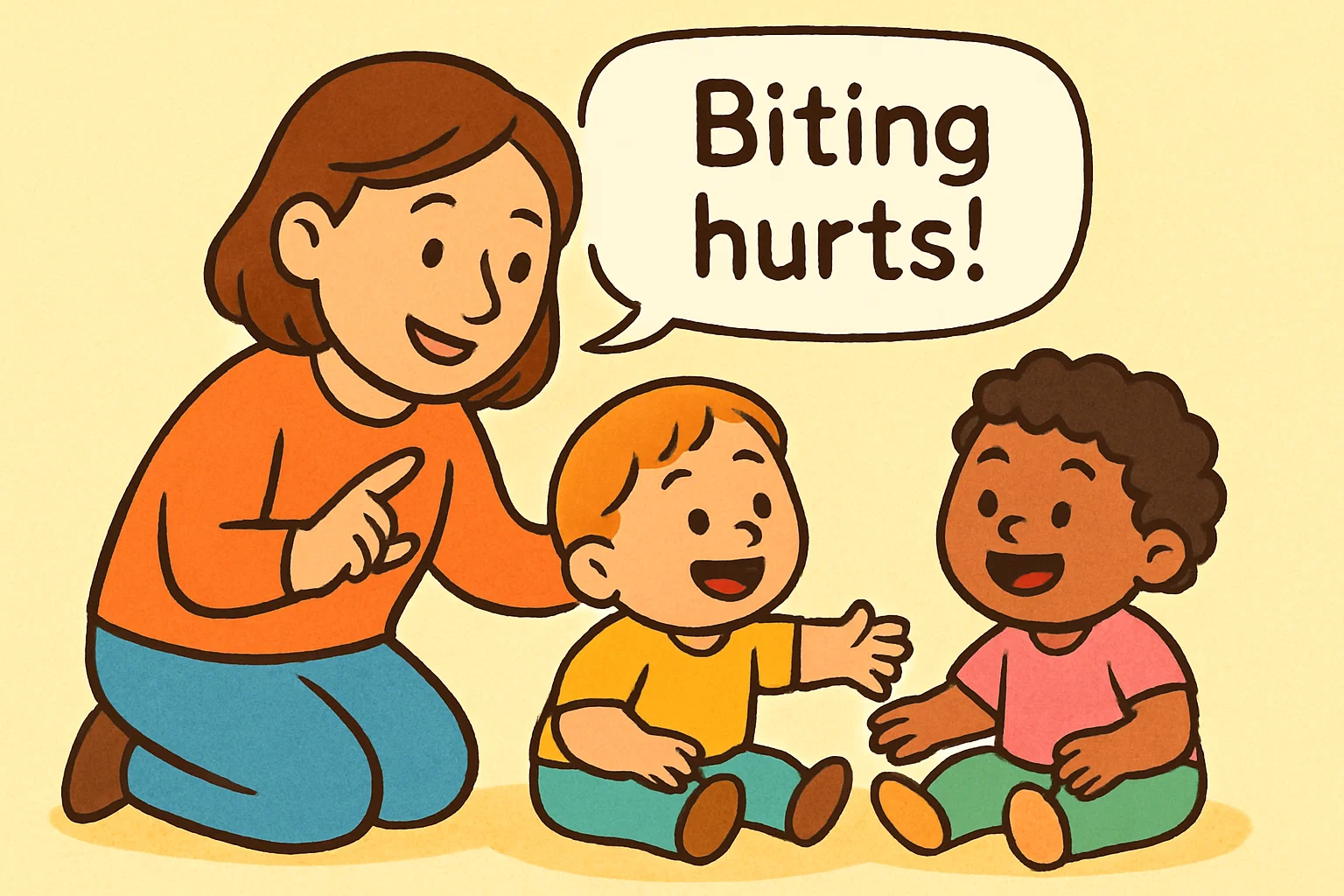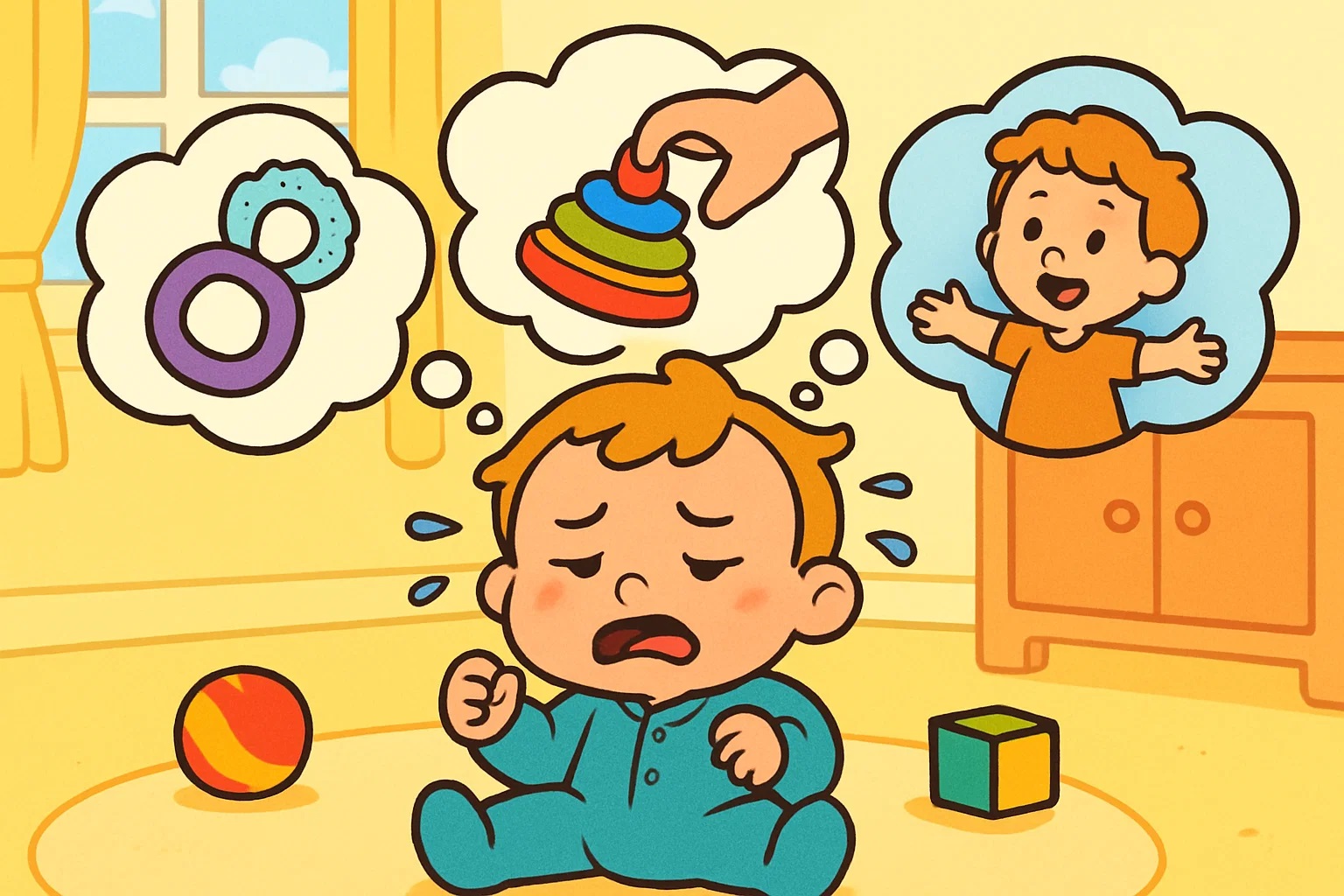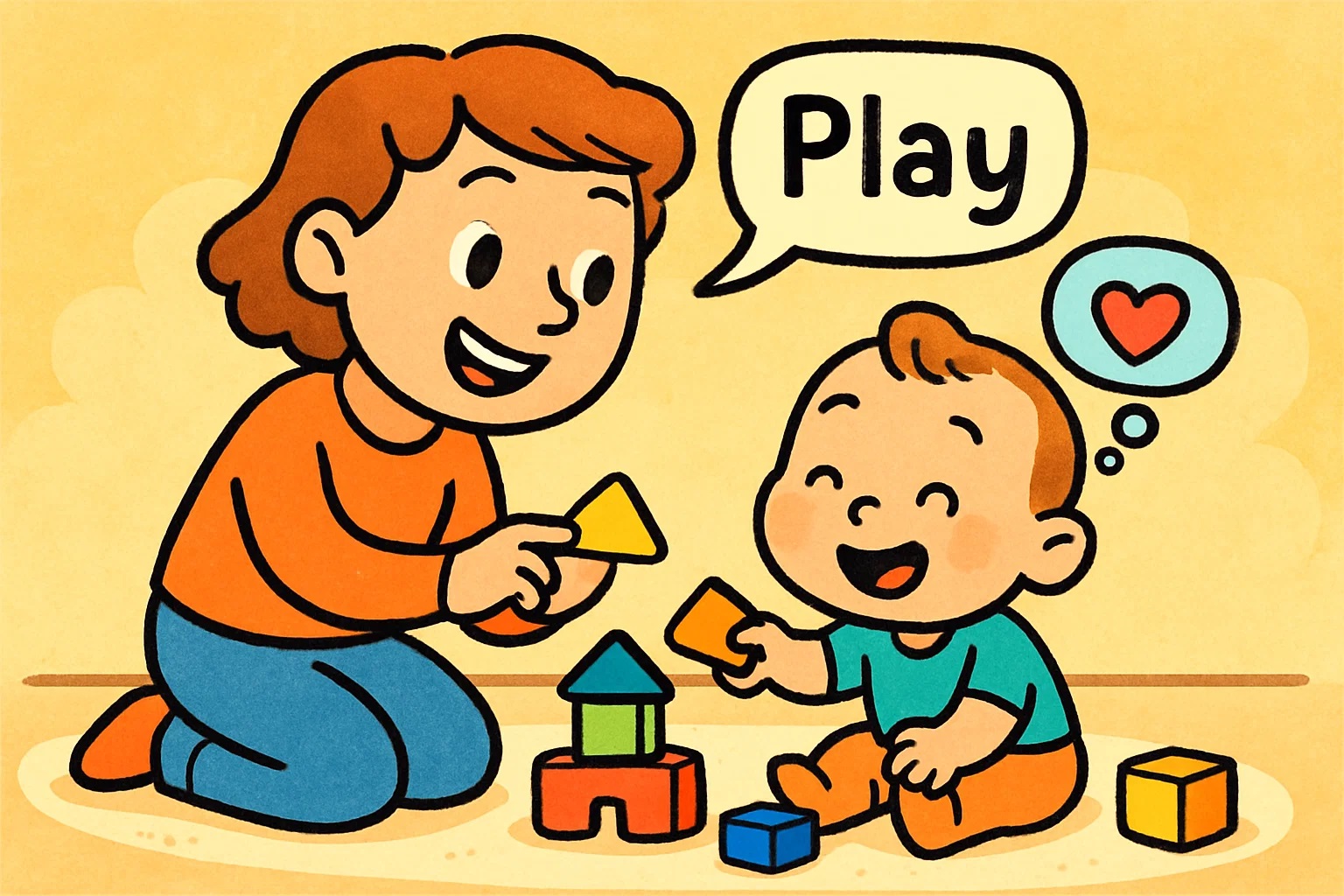How To Handle Kids Biting: Advice and Solutions

When your kid is biting another kid at daycare or sinks their teeth into your arm during a tantrum, it can feel both shocking and embarrassing. Rest assured—biting is a normal part of child development that most babies and toddlers experience. Understanding why kids bite and knowing the best ways to handle it can help your child move through this challenging phase more quickly.
According to child development experts, approximately 20-25% of toddlers bite at some point between ages 1-3. While biting happens and may seem alarming, it’s typically a temporary phase that children outgrow as their language skills and emotional regulation develop. For children zero to three, this behavior is especially common.
Why Young Children Bite 🦷

Understanding the root causes behind why your child may bite is crucial for addressing the behavior effectively. Toddlers often bite for several developmental and emotional reasons that vary depending on their age and individual circumstances.
Age and Development Stages
Young children bite at different stages for varying reasons. Babies around 6-12 months may bite during feeding or while exploring their world through their mouth. This early biting often occurs when babies teethe, as they seek relief from sore gums. Toddlers between 12-24 months frequently bite because they lack the language skills to express their feelings effectively. At this stage, children understand more than they can communicate, leading to frustration that may result in biting incidents. Older toddlers (24-36 months) might continue biting as they learn social boundaries and test their independence. Even though their vocabulary has expanded, they may still resort to biting when overwhelmed by strong emotions or complex social situations.
| Age Range | Common Biting Triggers | Developmental Factor |
| 6-12 months | Teething, exploration | Oral development phase |
| 12-24 months | Communication frustration | Limited vocabulary |
| 24-36 months | Social conflicts, testing limits | Emotional regulation development |
Emotional Reasons
Children often bite as a way to express emotions they cannot yet verbalize. When your kid feels angry, frustrated, excited, or overwhelmed, biting may serve as their primary communication tool. Toddlers may bite when they feel threatened, want to get attention, or experience sensory overload. If you think your child might be biting for these reasons, it’s important to observe their behavior closely. Dr. Sarah Martinez, a pediatric psychologist, notes: “Biting becomes a problem when children consistently use it to communicate instead of developing healthier coping mechanisms.” Young children haven’t yet learned appropriate ways to express intense feelings, making biting their go-to response during emotionally charged moments. Some children are more prone to biting when they’re tired, hungry, or experiencing changes in routine. These physical and environmental stressors can lower a child’s ability to self-regulate, increasing the likelihood of biting incidents.
Social Interaction
In group settings like daycare or preschool, biting often occurs during social conflicts over toys, space, or attention. Kids this age are still learning to share, take turns, and navigate peer relationships. When another child takes their toy or invades their personal space, some toddlers may bite to defend their territory or reclaim what they perceive as theirs. Biting can also happen during overstimulating play situations. When children become overly excited during group activities, they may bite as a way to release energy or express their enthusiasm inappropriately.
What To Do If Your Toddler Bites Another Child
How you respond to a biting incident significantly impacts whether the behavior continues or decreases. Your reaction should be immediate, calm, and focused on teaching rather than punishing.
Stay Calm and Respond Immediately
Take a deep breath before addressing the situation. Your calm response models emotional regulation for your child and prevents escalating the situation. React within seconds of the biting incident—delayed responses are less effective because toddlers have difficulty connecting consequences to actions that happened earlier. Avoid showing strong emotional reactions like anger or shock, as these responses may inadvertently reinforce the behavior by providing the attention your child was seeking.
Focus on the Child Who Was Bitten
Always attend to the kid who was hurt first. This approach demonstrates empathy and shows your child that biting causes harm to others. Check if the bite broke the skin and clean the area with soap and water if necessary. Comfort the injured child while your child who bit observes. This visual demonstration helps children understand the impact of their actions on others. Use phrases like “I need to help [child’s name] because they’re hurt” to reinforce the connection between biting and causing pain.
Remove Your Child From the Situation
Immediately remove them from the situation without making it feel like a reward. This isn’t a time-out but rather a necessary break to prevent further incidents and allow emotions to settle. Find a neutral space where you can talk to your child calmly about what happened. This removal should be matter-of-fact rather than punitive, helping your kid understand that biting results in losing access to play or social interaction.
Use Simple, Firm Language
Tell your child that biting is wrong using clear, age-appropriate language. Say “No biting” firmly but without yelling. For toddlers, keep your message short and direct: “Biting hurts. We don’t bite people.” Avoid lengthy explanations that young children cannot process. Instead, focus on one clear message that your child can understand and remember.
Explain That Biting Hurts 💔
Help your child understand that biting hurts others by pointing out the injured child’s reaction. Use simple language like “Look, [child’s name] is crying because biting hurts” or “Your teeth hurt [child’s name].” For children over 18 months, you can ask them to help comfort the child they bit, such as bringing a tissue or offering a hug (if the other child wants one). This approach builds empathy and helps children connect their actions to consequences.
Avoid Scolding or Shaming
Resist the urge to shame your child or use harsh punishment. Statements like “You’re a bad boy for biting” or “I’m disappointed in you” can damage your child’s self-esteem without effectively addressing the behavior. It’s crucial to avoid punishing your kid for biting in a way that is shaming. Instead, focus on the behavior itself: “Biting is not okay” rather than labeling your child as bad. This distinction helps children understand that while their behavior needs to change, they are still loved and valued.
Offer Comfort and Connection
After addressing the immediate situation, offer your child comfort and connection. Young children often bite when they feel disconnected or overwhelmed, so providing reassurance helps address underlying needs. Hold your child, speak softly, and help them regulate their emotions. Once they’re calm, you can discuss what happened and practice better responses for next time.
How To Get Your Child to Stop Biting

Prevention strategies are often more effective than reactive responses. By understanding your child’s patterns and triggers, you can create an environment that reduces biting incidents.
Identify the Triggers
Keep a simple log of when and where biting incidents occur. Note factors like time of day, your child’s emotional state, environmental conditions, and what happened immediately before the bite. Common triggers include:
- Transition times (arriving at daycare, leaving the park)
- Hunger or fatigue
- Overstimulating environments
- Conflicts over toys or attention
- Physical discomfort or illness
Understanding these patterns helps you anticipate and prevent situations that may lead to biting.
Teach Alternative Behaviors
Give your child words and actions to use instead of biting. Teach simple phrases like “Help me,” “My turn,” or “Stop” that they can use during conflicts. You can teach your kid these words during calm moments so they can access them during stressful situations. Show your child how to express feelings through acceptable physical actions like stomping feet, clapping hands, or squeezing a stress ball. These alternatives give children appropriate outlets for intense emotions.
Manage the Environment
Create environments that reduce competition and conflict. Provide duplicate toys during playdates, ensure adequate space for active play, and limit group activities when your child seems overwhelmed. In daycare or preschool settings, communicate with teachers about your child’s triggers and successful prevention strategies you’ve discovered at home.
Praise Good Behavior ⭐
Use positive reinforcement when your child handles conflicts appropriately. Praise your child with specific feedback: “I saw you use your words when you wanted that toy. That was great problem-solving!” Catch your child being gentle with others and acknowledge these positive interactions. Children are more likely to repeat behaviors that receive attention and praise.
Offer Teething Relief
For children who bite due to teething discomfort, provide appropriate teething toys, cold washcloths, or frozen fruit in mesh feeders. Address the physical discomfort that may be contributing to biting behavior. Talk to your pediatrician or your child’s doctor about safe teething remedies if your child seems particularly uncomfortable.
Use Redirection and Distraction
When you notice early warning signs that your kidmight bite, quickly redirect their attention to an appropriate activity. Offer a favorite toy, suggest a different game, or engage them in helping with a simple task. This proactive approach helps children avoid situations where they might resort to biting while learning better coping strategies.
Ensure Routines Are Consistent
Maintain predictable daily routines that help your child feel secure and reduce stress-related biting. Ensure your kid gets adequate sleep, regular meals, and sufficient physical activity. When routines must change, prepare your child in advance using simple language and visual cues when possible.
Frequently Asked Questions
When should I be concerned about my child's biting behavior?
Most children stop biting by age 3-4 as their language skills develop. However, reach out to your pediatrician or a child psychologist if nipping continues past age 4, becomes more frequent or aggressive, or if your child continues to bite despite consistent intervention efforts.
Should I bite my child back to show them how it feels?
Never bite your child back. This approach teaches that biting is acceptable behavior and can escalate aggression rather than reduce it. Children learn more effectively through gentle teaching and modeling appropriate behavior.
How do I handle biting incidents at daycare?
Communicate regularly with your child’s daycare providers about biting triggers and successful strategies. Ask about their nipping policy and work together on consistent responses. Most quality daycare programs have experience managing nipping phases and can partner with you effectively.
Is biting always a sign of aggression in toddlers?
Not necessarily. Toddlers often bite for non-aggressive reasons including exploration, communication frustration, excitement, or teething discomfort. Understanding the context and your child’s developmental stage helps determine the underlying cause.
How long does the biting phase typically last?
The biting phase usually lasts a few weeks to several months, depending on the child’s age, development, and how consistently adults respond to the behavior. Most children naturally outgrow nipping as their language skills improve and they learn better ways to express their needs and emotions.
